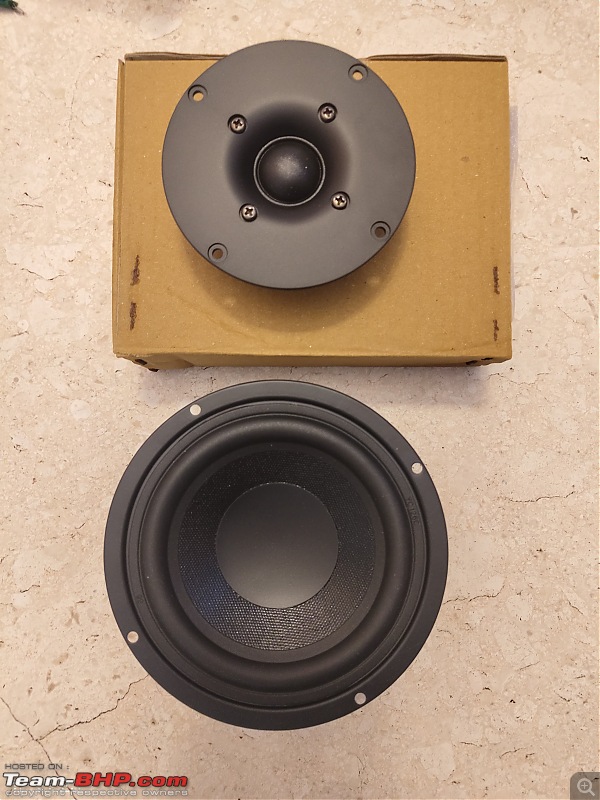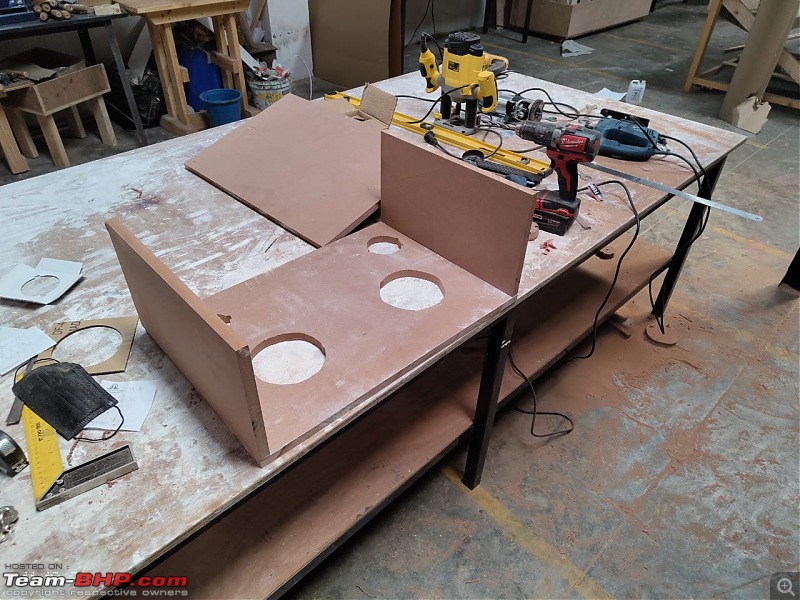Hi all, i am sharing my experience in building a 100W+100W Boom box for my Home and picnic Audio needs.
Being a audiophile always wanted good sounding speaker with good clarity on notes and sound quality reproduction.
I have done the Enclosure and Electronics wiring as part of my DIY here, i had bought quite some parts from various sources for making this happen.
The Need:
I wanted a Speaker box with full range capabilities and can be transported by car, also with docking table at house to convert has a Music system on my living room.
Definitely wanted a Bluetooth capability as Audio can be streamed wirelessly from TV, phone , PC.
Search for Quality Speakers
The tricky part here is sourcing a Home theater or Hi-Fi speaker is hard, as there is not much of a B2C crowd, as you cannot really find a good quality speakers in Amazon and other regular online retail places.
I was also aware that using a Car Audio speakers for home Audio needs is not a right thing and usually car speakers are tuned for Car environment and its not a Flat response speakers and the coil tuning is done for Current based displacement than voltage based displacement, as cars are usually limited to 12V max , the coils will has less ohms <4ohms, so it can drive more current.
some link here for more understanding >>
Parameters considered in the build
- Output watts - 100W RMS Left , 100W RMS right ( total 200W RMS)
- Amplifier power supply
- Speaker characteristics
- enclosure volume and port tuning
The Amplifier:
I have considered
this particular amplifier for the build as i have good amount of experience with this Chip and its performance, TDA7498

Features:
- High power digital audio amplifier; power supply: DC 15-32V; output power: 100W+100W
- 90% high efficiency; please note that the differential inputs can minimize common-mode noise
- Output impedance 4-8 ohm; Four fixed gain settings available: 25.6 dB, 31.6 dB, 35.1 dB and 37.6 dB
- Output power: 100W+100W (Vcc = 36 V, RL = 6Ω, THD: 10%); Output power: 80W+80W (Vcc = 34 V, RL = 8Ω, THD: 10%)
- With short-circuit protection, over temperature protection; also with standby & mute features on this amp board
Amplifier power supply:
As the Amp can run upto 32V and as its a audio system, i would always go for a isolated power supply which is harder to find but the trick is to use a regular Laptop charger which is ideal and comes with proper cables .
I had used a iball laptop charger 19V, which i had already, but you can pretty much use any between 15V to 32V.
Speaker characteristics
This is a important section as it defines the quality of the speaker and how efficient in terms of reproducing sound close to original signal.
I will not add too many parameters here and try keeping it simple.
Most of us look for speaker watts and maybe Ohms to find the right speaker, but there are few more other specs which defines speaker quality which most of manufactures do not disclose these are called
Thiele-Small Parameters
First let me explain basic parameters like watts and ohms,
Watts: This parameter explains the amount of input power it can handle, mostly there will be two types of watts mentioned
1)
Rated watts :This is the watts the speaker is designed to run most of the time >90% of time
2)
Peak or Max watts: This is the watts the speaker can handle in short bursts without Damaging itself <10% of time.
Ohms: This parameter gives DC resistance between coil terminals, usually this is for matching speakers with amplifiers, Amplifiers come with designed Ohms limit for speakers it can run, and it can also affect output performance of amplifiers if paired properly.
say if your amp can run 4ohms speakers, you can run a 4ohm speaker or speaker network, if a amplifier of 4ohm is paired to a 8ohm speaker the amplifier just cannot run the same watts of output over the higher rated ohm speaker, and will lead to distortion , audio quality issues and thermal issues.
The effect is vise versa of 4 ohm speaker is paired with a 8ohm Amplifier.
Did you notice the word Network i mentioned below? what if i say if you are stuck with a 2 no's of 8 ohm speaker with a 4ohm amplifier?
you can basically run two 8 ohm speakers in parallels to convert final two leads to a 4ohm speaker network, which your amplifier can run it seamlessly,
same you can do in series to add ohms.
 Speaker Quality parameters:
Speaker Quality parameters:
Q factor of speaker: a unitless number that describes how the speaker's suspension and motor control cone oscillation at its resonant frequency
As your car suspension has a spring and a damper, speaker also has the same, so it has its natural frequency at which it takes less watts but generates maximum sound output (dB)
Natural frequency Fs will be your speakers tuned frequency or center frequency, where other frequencies on other far ends of spectrum will have lower sound output or less speaker response.
There are 3 Q factors in a speaker to consider while buying, for more detailed please visit
here for more understanding.
Qts - toal Quality of speaker
Qes - speakers Electrical quality
Qms - speakers Mechanical quality
Sensitivity - movement or sound producing sensitivity of speaker for less voltage or watts, the average output across the usable frequency when applying 1Watt/1Meter (higher sensitivity speakers produce good treble response)
I will not explain the above terms, as you can visit the link shared for understanding, but will share what is a good value and what is not.
Qts Range :0.4 and 0.7 indicates suitability for a sealed enclosure. Qts of 0.7 or above indicates suitability for free-air or infinite baffle applications
Qes Range : lower the better
Qms Range : lower the better
both Qms and Qes are resistances in mechanical and electrical side of speaker to produce sound, will help you design the enclosure based on these two parameters. ideally lesser is better.
Enclosure Volume and Tuning:
Every speaker needs a good enclosure for sounding best, the design of enclosure is something highly debated and lot of experts still understanding this, example ideal shape of a speaker is actually a spherical speaker than a cube, due to manufacturing constrains Cubes are much easier.

I had calculated the speaker volume and port based on the some online references, i will leave a link
here for your computation
Usually ports are used to tube low frequency response (bass) i had tuned for 50Hz with a 3inch PVC plumbing tube with 150mm length for the enclosure i have used, you need to use enclosure volume to get port diameter and length.

After multiple research i had filtered down to
doogesound speakers.
Mid Range -DE525-01 Woofer 5.25" 4Ohms 50 Watts
tweeter - DE15-04 SILK DOME TWEETER 4" 8Ohms 40W
Sub woofer -DE800-01 Woofer 8" 4Ohms 80 Watts
Speaker crossover network - DE80R-07 2 WAY CROSSOVER
If you have good budget and can import speakers look for
peerless speakers
They are the best you can find and speaker parameters are out of the world and will provide IMAX level output. you can buy these speakers from
DIGIKEY website. The Design
I had used a CAD software to Generate approximate design and dimensions, as it will be progressive over the build i had chosen to change some design elements over the build time.

As you see i had gone for a retro design with removable legs which can be replaced by trolley wheels for portability.
The Build:
I had purchased 8x4 feet 20mm High density MDF for the build and taken it to a nearby
DIY woodworking place for all my wood works
Some videos of working
Photos of build 





Bluetooth Module for the build:
xcluma MH-M28 Wireless Bluetooth BLT 4.2
I had also considered a
APTx CSR8645 Bluetooth module with Mic for calling with buttons for music control, but it comes with dual output which needs two amps for each side of speaker as the output is bridged(4 wire), go gone for MH-M28 for now because my amp accepts single sided output (3 wire input).
I also have used polyester sponge inside the enclosure for increasing enclosure design volume to make it feel like a big speaker.
Cost :
speakers :7k
MDF :2k
Glue and consumables:500rs
DIY garage :1.5k
Elbow grease : 2 days
final look  Final Audio quality and thoughts:
Final Audio quality and thoughts:
As you might have noticed i had switched once of the 5inch speaker with 8in woofer, this made hell of a difference with Bass and added a full range to the boom box, if you are planning to make it as Front speakers for Home theater, 5inches are fine as that setup had good midrange performance and voice clarity.
My friends who had come over mentioned their Sony boombox worth 25k sounds 50% of what i had made.
Overall very happy with the build and planning to make two more as my home theater front speakers.
I had left it look rustic for now, I will be also adding a lithium pack so it can be made portable, will share pics of insides of speaker box soon with fitment of Amplifier and networks.
I might add in some analogue DB meters for looks.
 (43)
Thanks
(43)
Thanks
 (4)
Thanks
(4)
Thanks
 (3)
Thanks
(3)
Thanks
 (9)
Thanks
(9)
Thanks
 (1)
Thanks
(1)
Thanks
 (1)
Thanks
(1)
Thanks
 (1)
Thanks
(1)
Thanks
 (1)
Thanks
(1)
Thanks
 (1)
Thanks
(1)
Thanks
 (4)
Thanks
(4)
Thanks
 (1)
Thanks
(1)
Thanks
 (1)
Thanks
(1)
Thanks
 (2)
Thanks
(2)
Thanks


















